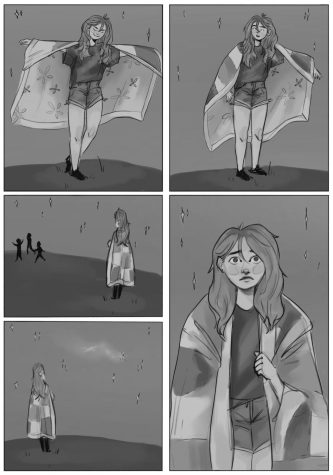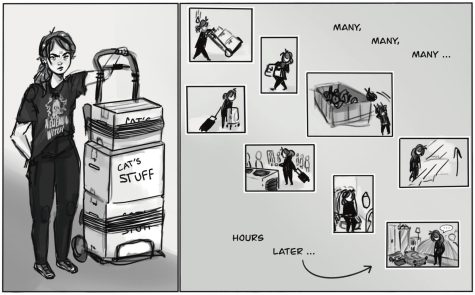Honne presents softer side of hyper electronic dance music
February 12, 2018
Artist utilizes electronic silky style to seduce listeners’ ears.
The song “Good Together” by Honne begins to play. A series of crisp snaps shatter your focus and you’re introduced to a syrupy voice. The song melts your worries away with its melded melody and you can’t help but feel romantic.
James Hatcher and Andy Clutterbuck both record, write and produce their music in the band Honne. From Bow, London, the electronic pop duo met in college while taking board at the local Young Men’s Christian Association. Hatcher used to give guitar lessons, and Clutterbuck was a music technician who taught children computer skills with music.
“We met at a dinner one time,” Clutterbuck said in an interview with Kyle Stevens from the Huffington Post. “Skipping forward four years, we were working together all the time. We would write music together. It was just a case of figuring out how to do stuff. About two years ago we officially started HONNE.”
The duo selected the name “Honne,” which in Japanese means “true sound” or “real intentions.”
“I’ve always been fascinated with Japanese culture,” Clutterbuck said in an interview with The Observer’s Jillian Scheinfeld. “In terms of how we found the name, we stumbled upon it and looked into the meaning and thought it was perfect, considering what we were talking about.”
With little success in the beginning, the duo released their first track on the album “Warm On A Cold Night” in 2016. Now with 6,040,159 views on YouTube, the song delivers a slick, groovy sound that traps the listener in musical molasses. It is available for purchase on iTunes, Google Play and streaming on Spotify, Apple Music and Deezer.
Electronic music has a reputation for loud festivals, expressive clothing and spectacles, but Honne is a great example of the new direction this style is taking by making electronic music with a different tone of voice. By blending the barriers between genres and infusing lyrical creativity, Honne’s techno dance pop sound is a perfect product of 21st century music.
Mack Powers, a musician and fourth-year student at Oregon State University, first heard Honne after his friend’s recommendation.
“I really enjoy the laid-back side of electronic music. They aren’t writing bangers for Impulse, but they are writing actual music, which I believe has been underrepresented in electronic music,” Powers said. “When you think of EDM (electronic dance music) you think of festivals, drums and lights and confetti, but as someone who has been a musician my whole life, it’s nice to see real songwriting get back into it, and hear what everyone has learned from the dance music scene.”
This shift in the creation and distribution of music opens up the types of experiences you can make with sound.
Kristin Spielman is a junior studying biohealth sciences. This past year she became a member of the all-female acapella choir Divine.
“I feel like any genre can be done well, but I like how each artist brings their own twist to it,” Spielman said. “Electronic is really cool because you can really go anywhere with it; it’s almost harder because you’re up there not necessarily giving them something to see, so you have to entertain the crowd some other way.”
Spielman doesn’t typically listen to electronic music, but likes Honne’s ability to blend soulful music and electronic music in a seamless way.
“I think it’s cool how they bring older music into the newer sound,” Spielman said.
Luke Yokoyama is an electronic composer studying music emphasis at Linn Benton Community College. After he graduates, he plans to follow a career in sound design, music production or to become an audio technician.
“(Electronic music) festivals are popular because the music is easy to get into,” Yokoyama said in a phone interview. “Music with a heavy amount of pulsing or a good downbeat that makes sense to you is enjoyable because you don’t need to think; you can let go and enjoy the music for what it is.”
With the use of synthesizers, it’s now easier to create a full sound even with only two people.
These neat musical contraptions were used in the music wave of the late 1970s, and they are used to imitate various instruments like the piano, flute, organ and abstract sounds, and really took hold in Japanese music.
Welcomed by a low voice in the song, “Warm On A Cold Night,” the listener settles into a boutique sound that drops into a rhythmic downbeat which reveals Clutterbuck’s crisp voice.
The phrase, “You can keep me warm on a cold night,” is placed after segments describing how special this girl is. Overlooking the obvious warmth needed on a cold night, the phrase recreates the girl he’s talking about. One can understand that she is warm with a vibrant personality and beauty. A cold night could be a bad day, or a moment of sadness, so her ability to make him feel better really resonates within the music, which is his expression of appreciation.
A perk of being an artist in 2018 is that you have a plethora of genres, styles and techniques that you can admire, imitate or build from. Honne doesn’t refrain from taking advantage of their musical influence.
“It was really hard; you want to put the tracks on there that have helped define you and get you moving, but you also need to put enough new tracks on there, otherwise it’s all the old stuff,” Hatcher said to Huffington Post about the “Warm On A Cold Night” album. “It was a balancing act of putting five old tracks on it while combining it with the new stuff.”
The romantic album sweeps you off your feet into a cloud of funky bliss. The plucky saunter of the music creates a sultry and soothing vibe. Borrowing conventions used in a variety of different genres and decades, the sound of the album conveys an intimate message attached to desire and comfort, while also delivering a fun and energetic kick of rhythm.
“Electronic music is a whole different ballpark. I wouldn’t say that Electronic music in general is harder to become successful with, but it’s much more difficult in the sense that you have to learn skills and techniques within the studio that is completely different from just creating a piece of music and sending it to someone else to have your music mixed and mastered,” Yokoyama said.
Whether it be on finely pressed records or downloadable files, music has the ability to emulate what we think.
“Music today is more accessible, and as far as integrity goes I don’t think that accessibility changes it,” Powers said. “When it comes to intention you’ll always have people that want to sell top 40 songs, but you’ll also have people who are about the music.”
We have the choice to maintain traditional music production techniques, as well as the chance to dapple in our technological manipulation of sound, but in the end music still represents a part of who we are and how we feel.
























































































































